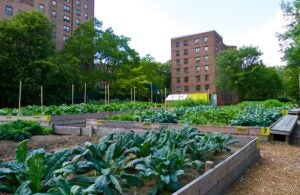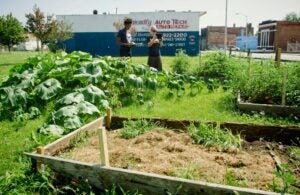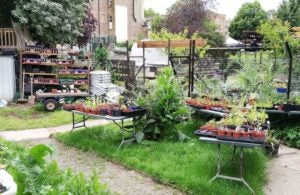Urban agriculture, the practice of farming within the confines of a city, is becoming increasingly popular worldwide and is touted as a way to make cities and urban food systems more sustainable. By some estimates, between 20 percent and 30 percent of the global urban population engages in some form of urban agriculture.
However, a new international study by the University of Michigan finds that fruits and vegetables grown in urban farms and gardens have an average carbon footprint six times greater than conventionally grown produce.
It’s no secret that large-scale conventional agriculture is very efficient. While conventional farms are more easily able to grow crops using high-tech solutions, crop protection products, and fertilizers, urban farms often find themselves limited by materials and infrastructure.
Large-scale rural farms are a win when you’re looking at keeping populations of people fed. And while there are shortfalls in this regard to urban farms, they do have important benefits, such as connecting individuals in communities to agriculture and providing opportunities to address the challenges of food deserts and food security gaps.
“Urban agriculture offers a variety of social, nutritional, and place-based environmental benefits, which make it an appealing feature of future sustainable cities. This work shines light on ways to ensure that urban agriculture benefits the climate, as well as the people and places it serves,” said study co-lead author Jason Hawes, a doctoral student at Michigan’s School for Environment and Sustainability.
The new study was published today in the journal Nature Cities.

Not all crops are equal in urban farms
Three types of urban agriculture sites were analyzed: urban farms (professionally managed and focused on food production), individual gardens (small plots managed by single gardeners), and collective gardens (communal spaces managed by groups of gardeners).
For each site, the researchers calculated the climate-altering greenhouse gas emissions associated with on-farm materials and activities over the lifetime of the farm. The emissions, expressed in kilograms of carbon dioxide equivalents per serving of food, were then compared to foods raised by conventional methods.
Inputs to the urban agriculture sites fell into three main categories: infrastructure (such as the raised beds in which food is grown or pathways between plots), supplies (including compost, fertilizer, weed-blocking fabric, and gasoline for machinery), and irrigation water.
On average, food produced through urban agriculture emitted 0.42 kilograms of carbon dioxide equivalents per serving, six times higher than the 0.07 kg CO2e per serving of conventionally grown produce.
“Most of the climate impacts at urban farms are driven by the materials used to construct them — the infrastructure,” Goldstein said. “These farms typically only operate for a few years or a decade, so the greenhouse gases used to produce those materials are not used effectively. Conventional agriculture, on the other hand, is very efficient and hard to compete with.”
Surprisingly, though, a few city-grown crops equaled or outperformed conventional agriculture under certain conditions.
Researchers discovered that tomatoes, for example, grown in the soil of open-air urban plots had a lower carbon intensity than tomatoes grown in conventional greenhouses. In contrast, the difference in emissions between conventional and urban agriculture was non-existent for air-freighted crops like asparagus.
These findings indicate that the type of crops grown in urban gardens might be worth considering.
“The exceptions revealed by our study suggest that urban agriculture practitioners can reduce their climate impacts by cultivating crops that are typically greenhouse-grown or air-freighted, in addition to making changes in site design and management,” said Hawes.

Making low-tech urban agriculture more carbon-competitive
Researchers deduced that studies such as extending the lifetime of urban agricultural materials and structures such as raised beds, composting infrastructure, and sheds could contribute to reduced carbon footprints. A raised bed used for five years will have approximately four times the environmental impact per serving of food as a raised bed used for 20 years.
In addition, urban gardens can conserve carbon by engaging in “urban symbiosis,” which includes giving a second life to used materials, such as construction debris and demolition waste, that are unsuitable for new construction but potentially useful for urban agriculture.

The most well-known symbiotic relationship between cities and urban ag is composting. The category also includes using rainwater and recycled gray water for irrigation.
In a survey conducted for the study, urban farmers and gardeners overwhelmingly reported improved mental health, diet, and social networks. While increasing urban agriculture’s “nonfood outputs” does not reduce its carbon footprint, “growing spaces which maximize social benefits can outcompete conventional agriculture when urban ag’s benefits are considered holistically,” according to the study authors.
»Related: Los Angeles has a massive carbon footprint — but makes animal ag its scapegoat


